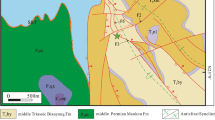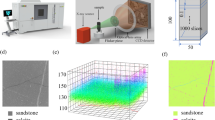Abstract
To reveal the influence of different loading conditions on the damage evolution of jointed sandstone, the numerical model with realistic mesostructure was established using CT scans and RFPA3D. Moreover, uniaxial compression tests of similar simulated specimens were performed. Three-dimensional fractures were extracted and reconstructed. A digital image-based rock microscopic scale fractured box dimension algorithm was written in MATLAB to analyze the three-dimensional fractal features of the AE fields. Studies have revealed that plane-to-plane and point-to-plane loading are both the mixed failure of tension and compression. Whereas point-to-point loading is a compression failure, and multi-point loading is a tensile failure. There are significant variations in damage characteristics and evolution of multi-point loading; the specimen’s fractal dimension is 2.5622, which is the largest, and it has the most significant crack propagation, the most complicated rupture mode, and a relatively good damage effect. The fractal dimension determined by the AE field can quantitatively assess the mesoscale damage evolution. The research findings are significant in understanding the rules of jointed sandstone breakage and energy consumption, in addition to searching for an effective and energy-saving rock-breaking technology.
Article highlights
-
The influence of different loading conditions on the damage and fracture evolution of jointed irregular sandstone is investigated in three dimensions.
-
Using self-written programs, extract and reconstruct the fracture structure, quantify fractal characteristics of the whole fracture process.
-
The impact of different loading conditions on the mining and crushing was revealed.















Similar content being viewed by others
Explore related subjects
Discover the latest articles, news and stories from top researchers in related subjects.References
Chen MH, Mao JW, Bierlein FP, Norman T, Uttley PJ (2011) Structural features and metallogenesis of the Carlin-type Jinfeng (Lannigou) gold deposit, Guizhou province, China. Ore Geol Rev 43(1):217–234. https://doi.org/10.1016/j.oregeorev.2011.06.009
Chiu CC, Weng MC, Huang TH (2016) Modeling rock joint behavior using a rough-joint model. Int J Rock Mech Min Sci 89:14–25. https://doi.org/10.1016/j.ijrmms.2016.08.001
Cui HT, Wu ZH, Li LP, Wang J, Lou YL (2020) Numerical test study of the microscale failure modes and fractal analysis of lower Cambrian shale based on digital images. Adv Civil Eng S1:1–16. https://doi.org/10.1155/2020/8819711
He HY, Zheng LL, Liu H, Zuo YJ, Zheng LJ, Huang N, Wu YP (2021) Study on deformation mechanism and supporting method of large section soft surrounding rock chamber in underground Mine. China Mining Mag 30(07):199–204. https://doi.org/10.12075/j.issn.1004-4051.2021.07.007
Ishihara S, Kano J (2019) ADEM simulation for analysis of particle breakage of irregular shaped particles. ISIJ Int 59(5):820–827. https://doi.org/10.2355/isijinternational.ISIJINT-2018-688
Lang YX, Liang ZZ, Dong Z (2019) Reconstruction of 3D meso-pore model of basalt and numerical experiment of direct tension. Chin J Eng Sci 41(08):997–1006. https://doi.org/10.13374/j.issn2095-9389.2019.08.005
Liang ZZ, Tang CA, Tang SB, Zuo YJ (2007) Characteristics of fractal and percolation of rocks subjected to uniaxial compression during their failure process. Chin J Geotech Eng 09:1386–1391. https://doi.org/10.3321/j.issn:1000-4548.2007.09.017
Liu HY, Lindqvist PA, Kesson U, Kou SQ, Lindqvist JE (2012) Characterisation of rock aggregate breakage properties using realistic texture-based modeling. Int J Numer Anal Methods Geomech 36(10):1280–1302. https://doi.org/10.1002/nag.1053
Liu HY, Huang YS, Li KB, Zhang JH (2013) Test study of strength and failure mode of pre-existing jointed rock mass. Rock Soil Mech 34(05):1235–1241
Liu H, Zuo YJ, Wu ZH, Sun WJB, Xi SJ (2020) Study of concrete internal crack growth deformation law and fracture process using digital images. Concrete 1:32–37. https://doi.org/10.3969/j.issn.1002-3550.2020.01.008
Liu H, Zheng LL, Zuo YJ, Wu ZH, Sun WJB, Zheng LJ, Pan C, Lin JY, Zhu ZH, Hao ZB (2021a) Study on mesoscopic damage evolution characteristics of single joint sandstone based on Micro-CT image and fractal theory. Shock Vib. https://doi.org/10.1155/2021/6547028
Liu H, Zuo YJ, Wu ZH, Sun WJB, Zheng LJ, Lou YL, Lin JY, Wan RJ (2021b) Fractal analysis of mesoscale failure evolution and microstructure characterization for sandstone using DIP, SEM-EDS, and Micro-CT. Int J Geomech 21(9):04021153. https://doi.org/10.1061/(ASCE)GM.1943-5622.0002110
Lou YL, Wu ZH, Sun WJB, Yin S, Wang AL, Liu H, Zuo YJ (2020) Study on failure models and fractal characteristics of shale under seepage-stress coupling. Energy Sci Eng 8(5):1634–1649. https://doi.org/10.1002/ese3.621
Lu YJ (2010) Statistical approach and numerical simulation of strength size effect of quasi-brittle materials. Tsinghua University, Beijing
Meng J, Huang J, Sloan SW, Sheng D (2018) Discrete modeling jointed rock slopes using mathematical programming methods. Comput Geotech 96:189–202. https://doi.org/10.1016/j.compgeo.2017.11.002
Niu S, Jing H, Kun HU, Yang D (2010) Numerical investigation on the sensitivity of jointed rock mass strength to various factors. Min Sci Technol 4:5. https://doi.org/10.1016/S1674-5264(09)60238-6
Rubinstein R (1983) Simulation and the Monte Carlo Method
Song HL, Wu ZH, Wang AL, Sun WJB, Zuo YJ (2020) Study on the microscale tensile properties of lower Cambrian niutitang formation shale based on digital images. Geofluids. https://doi.org/10.1155/2020/8828965
Su H, Li CH (2011) Mesoscopic numerical simulation of acoustic emission experiment in rock compression failure under different confining pressures. J Univ Sci Technol Beijing 33(11):1312–1318. https://doi.org/10.13374/j.issn1001-053x.2011.11.001
Tang CA, Liu HY (2007) Chapter 16 numerical investigation of particle breakage as applied to mechanical crushing. Elsevier, Amsterdam, pp 661–739
Tang CA, Liu HY, Zhu WC, Yang TH, Li WH, Song L, Lin P (2004) Numerical approach to particle breakage under different loading conditions. Powder Technol 143:130–143. https://doi.org/10.1016/j.powtec.2004.04.026
Tang MT, Wu ZH, Wang AL, Zuo YJ, Sun WJB (2021) Study on the microscopic fracture process and acoustic emission of shale based on digital image. Geofluids 2021:1–14. https://doi.org/10.1155/2021/8874918
Wang Y, Forssberg E, Klymowsky R (1998) Fine comminution of limestone by roller press—stirred ball milling. Aufbereitungs Technik 39(6):267–278
Wang G, Shen JN, Liu SM, Jiang CH, Qin XJ (2019) Three-dimensional modeling and analysis of macro-pore structure of coal using combined x-ray ct imaging and fractal theory. Int J Rock Mech Min Sci 123:104082. https://doi.org/10.1016/j.ijrmms.2019.104082
Wang YB, Wen ZJ, Liu GQ, Wang JG, Bao ZQ, Lu KQ, Wang DC, Wang BZ (2020) Explosion propagation and characteristics of rock damage in decoupled charge blasting based on computed tomography scanning. Int J Rock Mech Min Sci 136(3):104540. https://doi.org/10.1016/j.ijrmms.2020.104540
Weibull W (1951) A statistical distribution function of wide applicability. J Appl Mech 18:293–297. https://doi.org/10.1093/qjmam/6.4.453
Wu ZH, Zuo YJ, Wang S, Yi T, Li B (2016) Numerical simulation and fractal analysis of mesoscopic scale failure in shale using digital images. J Pet Sci Eng 145:592–599. https://doi.org/10.1016/j.petrol.2016.06.036
Wu N, Liang ZZ, Li YC, Li H, Li WR, Zhang ML (2019) Stress-dependent anisotropy index of strength and deformability of jointed rock mass: insights from a numerical study. Bull Eng Geol Environ 78(8):5905–5917. https://doi.org/10.1007/s10064-019-01483-5
Wu ZH, Lou YL, Yin S, Wang AL, Chen B (2020) Acoustic and fractal analyses of the mechanical properties and fracture modes of bedding-containing shale under different seepage pressures. Energy Sci Eng 8(10):3638–3656. https://doi.org/10.1002/ese3.772
Wu ZH, Song HL, Li LP, Zhou ZQ, Lou YL (2021) Study on the damage evolution process and fractal of quartz-filled shale under thermal-mechanical coupling. Geofluids. https://doi.org/10.1155/2021/8843120
Xiao J, Zhang X, Zhang D, Xue L, Wang Y (2020) Morphological reconstruction method of irregular shaped ballast particles and application in numerical simulation of ballasted track. Transp Geotechnics 24:100374. https://doi.org/10.1016/j.trgeo.2020.100374
Xie HP (1996) An introduction to fractal-rock mechanics. Science Press, Beijing
Xie XF, Tao M, Wu QH, Wang ZW, Shang XY, Liu K (2017) Dynamic properties of sandstones with different shapes. J Cent S Univ 48(09):2441–2448. https://doi.org/10.11817/j.issn.1672-7207.2017.09.024
Yang H, Liu J, Liu B (2018) Investigation on the cracking character of jointed rock mass beneath TBM disc cutter. Rock Mech Rock Eng 51(4):1263–1277. https://doi.org/10.1007/s00603-017-1395-8
Yang LA, Tm B, Hao WC, Ping CB (2020) Investigation on mechanical behaviors of shale cap rock for geological energy storage by linking macroscopic to mesoscopic failures. J Energy Storage 29:101326. https://doi.org/10.1016/j.est.2020.101326
Zhang H, Liu HY (2017) Simulation on the uniaxial compressive mechanical properties of rock mass with non-persistent and infilled joints. Min Res Dev 37(3):87–92. https://doi.org/10.13827/j.cnki.kyyk.2017.03.020
Zuo YJ, Zhang Q, Xu T, Liu ZH, Qiu YQ, Zhu WC (2015) Numerical tests on failure process of rock particle under impact loading. Shock Vib 2015:1–12. https://doi.org/10.1155/2015/678573
Acknowledgements
The financial support provided by the National Natural Science Foundation of China (Nos. 51774101, 51964007), the Guizhou Mining Power Disaster Early Warning and Control Technology Innovation Team, China (No. 2019-5619), the Startup Project for High-level Talents Training Project in Guizhou Province, China (No. 2016-4011); and the Guizhou Science and Technology Department (Grant Number [2021] general 516).
Author information
Authors and Affiliations
Corresponding author
Ethics declarations
Conflict of interest
The authors have the appropriate permission from responsible authorities to do the study on-site and have no conflict of interest.
Additional information
Publisher's Note
Springer Nature remains neutral with regard to jurisdictional claims in published maps and institutional affiliations.
Rights and permissions
About this article
Cite this article
Hao, Z., Zuo, Y., Liu, H. et al. Mesoscopic damage evolution characteristics of jointed sandstone under different loading conditions. Geomech. Geophys. Geo-energ. Geo-resour. 8, 92 (2022). https://doi.org/10.1007/s40948-022-00390-6
Received:
Accepted:
Published:
DOI: https://doi.org/10.1007/s40948-022-00390-6





